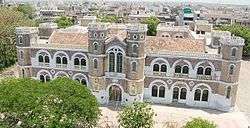Alfred High School (Rajkot)
| Mohandas Gandhi High School | |
|---|---|
|
Aerial view of Mohandas Gandhi High School | |
| Location | |
|
Jawahar Road, Rajkot India | |
| Coordinates | 22°17′55″N 70°48′06″E / 22.298492°N 70.801724°E |
| Information | |
| Type | Public |
| Established | 1885 |
| Founded | October 17, 1853 |
| Founder | H. H. Nawab of Junagadh |
| School district | Rajkot |
| Grades | 10+2 |
| Number of students | 720 approximately |
| Colour(s) | White, Navyblue |
| Athletics | Cricket, Football, hockey, |
| Affiliation | GSEB |
| Alumni | Mahatma Gandhi |
| Current Name | Mohandas Gandhi High School |
| Architect | Sir Robert Bell Booth |
The Alfred High School (also known as Mohandas Gandhi High School) in Rajkot is one of the oldest educational institutions in India today.
History
This school was constructed during British rule in India by political agent Kernel Singh, and was the first English school in the saurashtra (region). Originally called Rajkot English School, it was founded on October 17, 1853, and later became a full-fledged high school. By 1868 it came to be known as Rajkot High School, and was named Alfred High School in 1907. The present buildings of the Alfred High School were built for Kathiawar by the Nawab of Junagadh, Nawab Nawab Sir Muhammad Rasul Khanji Babi, and was named Prince Alfred, the Duke of Edinburgh, as a memorial. This School was opened in January, 1875 by Sir Philip Wodehouse, Governor of Bombay.[1]
Mohandas Gandhi
mahatma Gandhi graduated from Rajkot High School in 1887 at age 18.[2] Accounts vary on Gandhi's time at the school.[3] Several accounts suggest he was a quiet and academically unremarkable student who did not participate in sports or extracurricular activities.[2][4] Gandhi said of his schooling, "I had not any high regard for my ability. I was to be astonished whenever I won prizes and scholarships".[4] However, Rajmohan Gandhi suggests that this view comes from a misreading of his "self-deprecating" autobiography.[3] Out of 38 students who had passed the high school entrance examination, Gandhi was one of only two students in his year to matriculate. Following graduation Gandhi enrolled at the Samaldas College in Bhavnagar, where he stayed for one term before travelling to London.[3]
Following India's independence in 1947, the school was renamed the "Mohandas Gandhi High School" in honour of Gandhi.[5]
Notable alumni
- S. R. Rana, Indian political activist[6]
See also
References
- ↑ "Source", Retrieved on December 26, 2007
- 1 2 R. P. Misra (2007). Rediscovering Gandhi: Hind Swaraj Volume 1: Gandhi's Challenge to Modern Civilization. Concept Publishing Co. p. 102. ISBN 978-8180693755.
- 1 2 3 Rajmohan Gandhi (2006). Gandhi: The Man, His People, and the Empire. University of California Press. p. 17. ISBN 978-0520255708.
- 1 2 N. Jayapalan (2010). Indian Political Thinkers: Modern Indian Political Thought. Atlantic Publishers & Distributors Pvt Ltd. p. 156. ISBN 978-8171569298.
- ↑ "Colonial Tour of RMC", Retrieved on December 26, 2007
- ↑ Gohil, Dharmendrasinh Vaghubha (18 May 2015). "1-7". Contribution of Sardarsinh Rana in Freedom struggle of India 1870 to 1947. Shodhganga web (Thesis) (in Gujarati). Department of History, Maharaja Krishnakumarsinhji Bhavnagar University. pp. 4–. Retrieved 4 November 2016.
